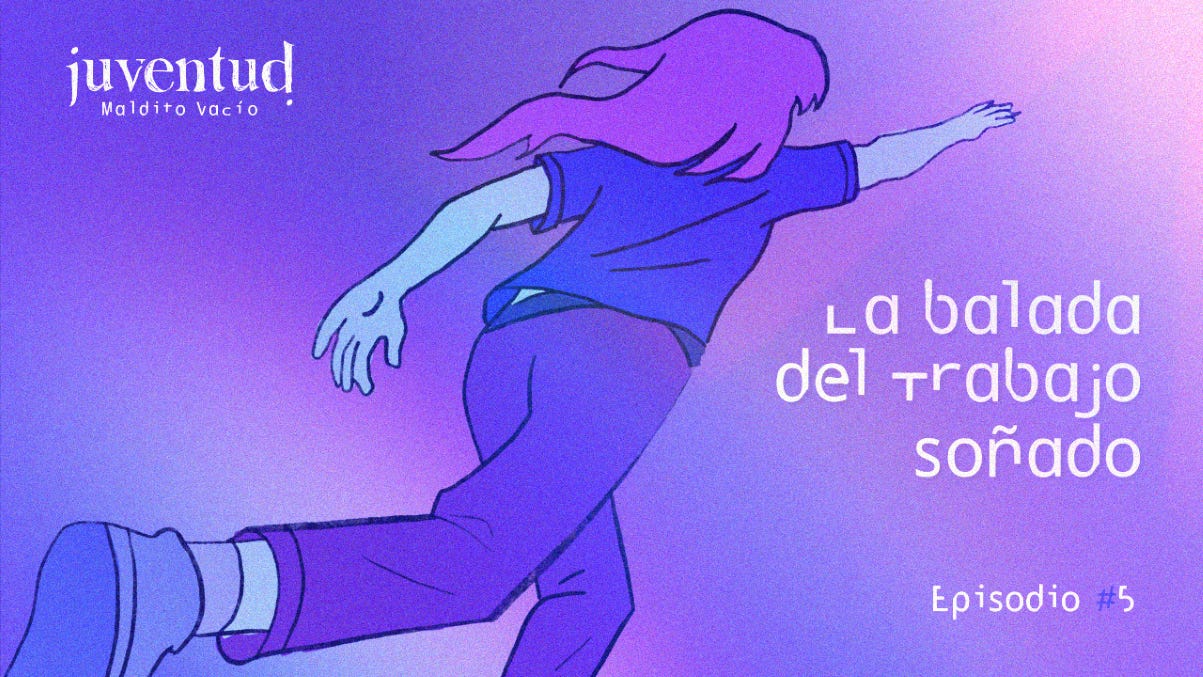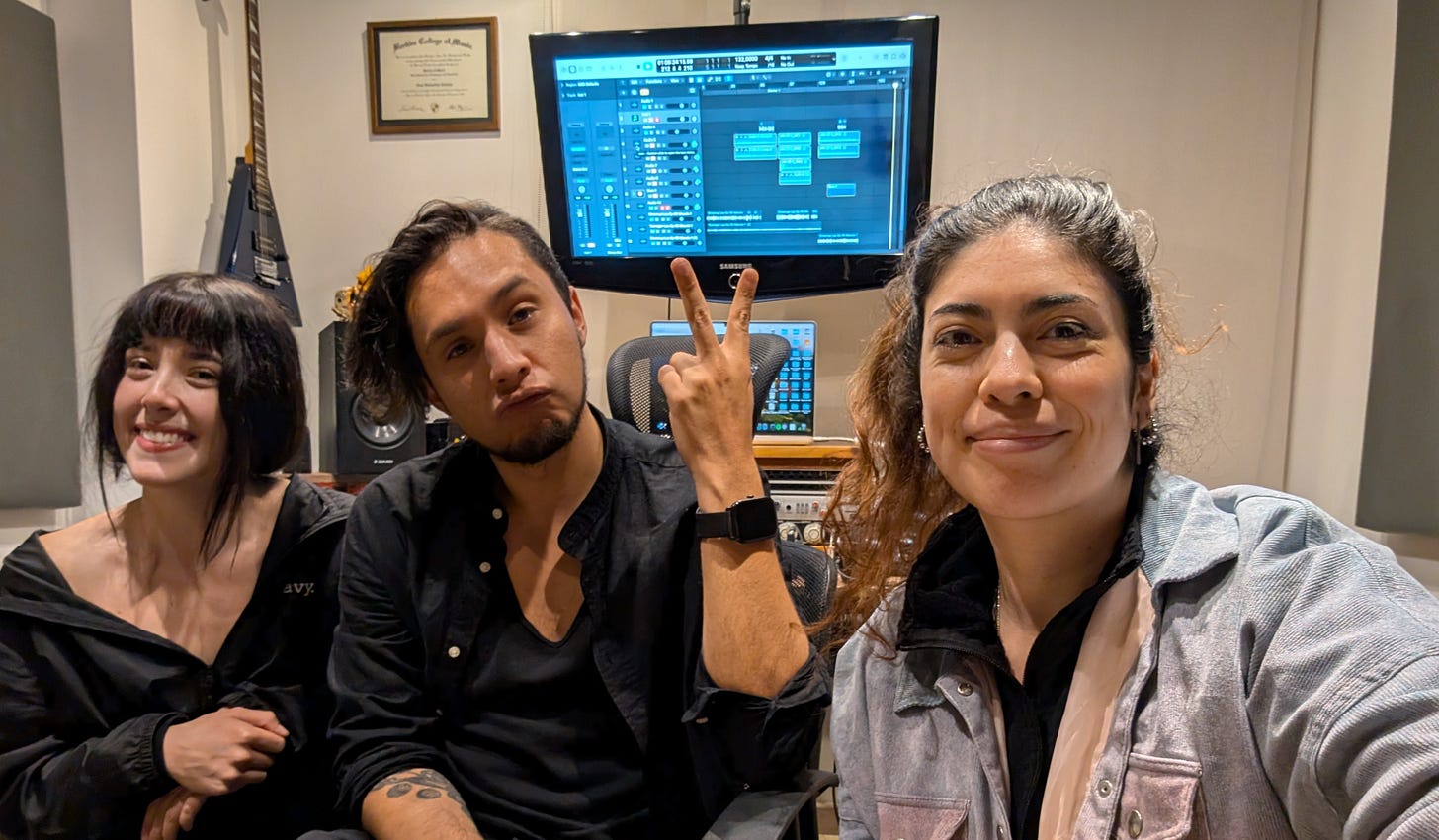I wrote a song! Juventud Maldito Vacío, new episode.
The backstage and creative process on how I turned a narrative script into a song
Feliz domingo.
Thank you for reading Escribir en Voz Alta. Today’s edition is very special because it summarizes a four-month creative process for a nine-minute episode that I’m incredibly proud to share.
I’ll tell you how I transformed a conventional script into a song in today's edition.
It all started as a narrative podcast script.
It all started as a script.
For those discovering Juventud Maldito Vacío for the first time: it’s a six-episode conceptual podcast about being in your twenties and trying to bridge that massive gap between who we are and who we dream of becoming. This first season has been an autobiographical journey about my teenage dream of becoming a youth radio DJ and the emotional rollercoaster of making that dream come true… and letting it go.
The fifth episode of this series is about that battle. If we were to frame it in terms of storyline, it would go something like this:
Ep 01: We introduce Laura’s world, her dream, and her first big mistake.
Ep 02: Laura falls into the Maldito Vacío, the dark side of the moon.
Ep 03: Laura achieves her dream, and realizes that radio isn’t about her and that the Maldito Vacío is much bigger than her own reality—it’s the void of an entire generation.
Ep 04: Thanks to her best friend, she finds her first way out of the Vacío. She starts wondering if her life should be defined by just one dream and what would happen if she left the radio.
Ep 05: Laura understands that in order to defeat the Maldito Vacío, she must save herself—and for her, that means quitting her dream job.
As you may know, I come from a background in narrative non-fiction podcasting, so my first instinct in writing this battle was to approach it as a standard narrative script. I started by asking a friend to interview me, then transcribed that interview and structured it. I also interviewed some of my colleagues from radio: Diego Bolaños, Sandra Defelipe, and Jane Ochoa.
What struck me the most in those interviews was realizing that, at different points, each of them had experienced breaking up with a job—whether this one or another—like an unrequited love. We all went through the illusion, the “I can change it” phase, and the countless disappointments. That emotional journey was what moved me the most, so I decided to focus my story on capturing it.
I transcribed the interviews, arranged everything chronologically, and from there, I built a structure—a story in scenes. Then, I followed the usual narrative script process: Once upon a time… Every day… Until one day, everything changed… Because of that… The first version of the story looked solid.
Take a look at its general shape: long paragraphs, few voice interventions. I kept writing, and by Act 2, I realized this was more of a chronicle meant to be read rather than listened to. By Act 3, I was only writing headlines and didn’t feel like creating more scenes. Day after day, I procrastinated finishing the story, feeling like I had cornered myself into writing this.
To explain it better, let me pause for a moment:
There is a part of this episode that is based on a real-life event: a series of reports of sexual harassment against young journalists in public radio. I exposed the case in October 2022, and to date, more than 30 testimonies have been added, with an open legal case on the matter. At the time, I was the first to speak out.
It was one of the most important acts of my journalism career. But it came at a very high emotional cost, which is why I feel I said everything I needed to say about it, and I don’t want to dedicate another word to it.
So, how was I going to end this story?
It became a poem.
Once again, friendship came to the rescue. I shared the script with Laura Hernández and NK Kelly. At the time, NK was writing Basket Case, which started as an artistic exercise and turned into a journalistic one. I wanted to go in the opposite direction. NK’s advice (which I’d pass on to anyone stuck in their writing) was:
Read aloud what you’ve written, pay attention to how your body reacts, where is this feeling? and follow what excites you the most. Always write what moves you the most.
Heartbreak was what kept calling me. And I realized that emotion had never really been captured in journalistic articles or interviews—that pain of loving a job that doesn’t love you back, that doesn’t take care of you.
I saved all the narrative versions of the story and started writing a poem instead—a medium that conveys emotions rather than journalistic facts.
The first draft was about five pages long, a raw stream of thoughts, a mix of prose and lyricism. Over the following weeks, I refined it down to three pages—Act I, Act II, Act III.
Then, I recorded myself reading it. It sounded flat. (That was me, trying not to be vulnerable.) So, I reached out to MJ García, a brilliant Colombian actress I met in San Francisco through Camilo Garzón and our live performance of Soroche.
MJ performed the poem, and for the first time, it sounded musical.
What if….?
This episode is a song.
A conversation with Nilsson made it clear: “Why tie yourself down to just one format? If this is art, let it be free.”
Once I accepted that, I recorded the poem in different voices—Lau the grown-up, Lau the rocker, Lau the little girl, Lau the journalist. It made sense that for my protagonist, a teenager who loves rock, this song would be her rebellious scream, showing everything she didn’t want.
During those recording sessions, the chorus melody emerged naturally:
"Sé que lo que quiero consigo y lo mejor de estar contigo era yo."
("I know that what I want, I get, and the best thing about being with you was me.")
Inspired by Bob Dylan’s titles and Leonard Cohen’s poetic style, I named it La Balada del Trabajo Soñado. Then, in November, when I arrived in Bogotá, I teamed up with Sebastián Izácigaa. We wrote the song in a single afternoon.
Out of all the takes, we chose one where my voice sounded natural and deeply moved. There was one where I belted it out, but this spoken-sung version made more sense for the story—my character is earning confidence as she sings.
It was pouring rain when Ellen Herrera arrived at the studio, and by some stroke of magic, she added stunning backing vocals at the end. They sound like Lau from the past and Lau from the future meeting each other.
Daniel Murcia’s sound design completed the between-worlds sensation we aimed for. Now, I know that turning this into a song was a good call.
La cereza del pastel: La portada animada cuadro a cuadro.
This is entirely the work of Nilsson Cajamarca. When Lau Correal and I created the series’ visuals, we always saw this episode’s cover as the long race toward our dreams—how that dream always seems further, and further away.
It’s also our character’s final push. She has just surfaced from the water world and is now heading straight into its opposite—the world of air. Just like so many young people feel, running and doing a thousand things before turning 30.
So, we wanted to freeze that race in time. We took Lau’s illustration and passed it to Diego Doncel, who animated it frame by frame. Then, we colored each frame and Nil brought it all together.
Here’s the process and the final result.
It’s time for this creature to walk out into the world.
Here it is—today, I present you The Ballad of the Dream Job. With immense gratitude to everyone who helped bring it to life.
Let me know your thoughts in the comments section of this video—I’ll be waiting for you.
P.S. The audio-only version will be available on Spotify until tomorrow (we're giving the animated cover a priority on YouTube ).
If you’d like to support this independent project, subscribe to this Substack.







